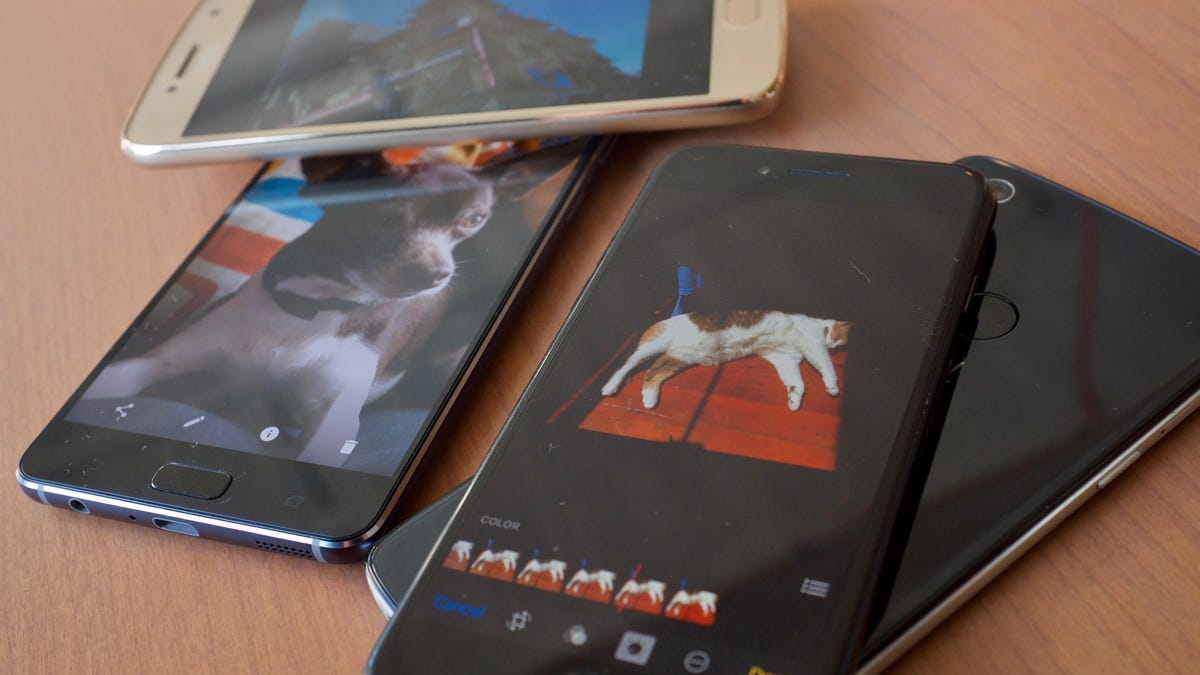How to make your iPhone and Android pictures look better
Whether you have an iPhone 7 Plus, a Galaxy S8 or a Google Pixel, here are 3 tips to make your photos look better.

No matter if you have the high-end Samsung Galaxy S8, the budget Alcatel Idol 5S or even an old iPhone 6, chances are you take photos with your phone. And whether your phone has the best camera or a modest camera, there are three quick tweaks to make your photos look better -- all with using the f-word: Filters.
So many photo apps
Before you make your first edit, know that there are hundreds of apps to edit photos including favorites like Instagram and VSCO. You can use those apps or the default photo editor on your phone (iOS Photos or Google Photos) to make these quick adjustments.
Straighten your photos
Maybe you took a picture at an odd angle or perhaps you're trying to get your subject perfectly centered a la filmmaker Wes Anderson, both are instances where straightening a photo can save the day.
Straightening lets you rotate a photo while zooming-in to square things off. The result is a picture that is better composed and looks more purposeful. Straightening works especially great for photos of people, buildings and landscapes.
Straighten your photo to make the subject better aligned for the viewer.
Start with the photo you want to straighten and follow these directions:
- iOS photos app: Tap on the sliders icon, then tap on the Crop tool. iOS will auto-straighten your picture. To override this, just slide your finger on the straighten wheel below the photo.
- Google Photos: Tap on the pencil icon, then tap on the Crop tool.
- Instagram: From the Filter/Edit screen, tap on the Edit button and then tap on the Adjust tool.
- VSCO: After importing your photo, tap on the slider icon, then tap a second time on the slider icon and then tap on the Straighten tool.
Get the right exposure
The auto settings on some phones ' cameras can make it capture too much light, overexposing your photo (like when it's really sunny). Other phones might do the opposite and underexpose the image by capturing too little light (like indoors at a restaurant).
If your photo looks too dark or too bright, use the exposure tool (sometimes called "Light") to raise or lower the overall brightness. Just be careful not to make too severe a change. A little adjustment goes a long way.
For a more nuanced solution use the highlights and shadows tools. The highlights tool brings back only those areas of the photo that are too bright and the shadows tool only the parts that are too dark.
To adjust the exposure, start with the photo you want to fix and follow these directions:
- iOS photos app: Tap on the sliders icon, then tap on the Adjust tool (knob icon) and then tap on Light. You can adjust the Light slider left or right to change the exposure. Or tap on the expand arrow to get individual controls for exposure, highlights and shadows.
- Google Photos: Tap on the pencil, then tap on the sliders icon and adjust the Light slider left or right to change exposure. Tap on the expand arrow to show individual controls for exposure, highlights and shadows.
- Instagram: From the Filter/Edit screen, tap on Edit to access tools for highlights and shadows. The brightness tool adjusts exposure.
- VSCO: Tap on the slider icon, then tap a second time on the slider icon to access tools for exposure, highlights and shadows.
Adjusting the Light slider changes the exposure.
Colors
Some phones, like the Samsung Galaxy S8, create photos with very rich colors. Other phones like the iPhone 7 Plus render photos more true to life, but sometimes leave you wanting a bit more color pop from your snaps. The solution to both is adjusting the saturation.
Like exposure, changing the saturation a little can go a long way. Desaturate things too far and your photo turns black and white (which can be cool if that's what you want). And if you oversaturate a photo it might look like it was colored with fluorescent highlighters.
Lowering the saturation can help improve photos taken under unpleasant lighting or where a person's skin looks like a bad tan. Raising the saturation can help the color in pictures of food pop just right.
To adjust the saturation, start with the photo you want to fix and follow these directions:
- iOS photos app: Tap on the sliders icon, next tap on the Adjust tool (knob icon) and then tap on Color. Move the Color slider left or right to change the saturation. Tap the expand arrow for more specific color tools.
- Google Photos: Tap on the pencil, then tap on the sliders icon. Move the Color slider left or right to change the saturation. Tap the expand arrow for more specific color tools.
- Instagram: From the Filter/Edit screen, tap on Edit to access the saturation tool.
- VSCO: Tap on the slider icon, then tap a second time on the slider icon to access the saturation tool.
The Color slider controls the saturation. Just a little adjustment goes a long way.
Next level editing
These are just a few quick tips. If you want more ways to improve your photos, try other tools in your photo editor. Also, many phones today can shoot RAW photos which gives you even more leeway to adjust your photos after the fact. Of course, taking better photos with you phone in the first place will help minimize the need to edit them later.

